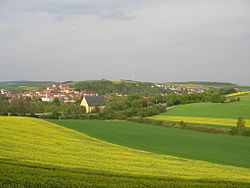Arnstein
| Arnstein | ||
|---|---|---|
 |
||
|
||
| Coordinates: 49°58′N 09°59′E / 49.967°N 9.983°ECoordinates: 49°58′N 09°59′E / 49.967°N 9.983°E | ||
| Country | Germany | |
| State | Bavaria | |
| Admin. region | Unterfranken | |
| District | Main-Spessart | |
| Government | ||
| • Mayor | Anna Stolz (bipartisanship) | |
| Area | ||
| • Total | 112.12 km2 (43.29 sq mi) | |
| Elevation | 228 m (748 ft) | |
| Population (2015-12-31) | ||
| • Total | 8,161 | |
| • Density | 73/km2 (190/sq mi) | |
| Time zone | CET/CEST (UTC+1/+2) | |
| Postal codes | 97450 | |
| Dialling codes | 09363 | |
| Vehicle registration | MSP | |
| Website | www.arnstein-online.de | |
Arnstein (![]() ) is a town in the Main-Spessart district in the Regierungsbezirk of Lower Franconia (Unterfranken) in Bavaria, Germany.
) is a town in the Main-Spessart district in the Regierungsbezirk of Lower Franconia (Unterfranken) in Bavaria, Germany.
The town lies on the banks of the river Wern and is roughly 20 km from Schweinfurt and 25 km from Würzburg.
Arnstein’s Stadtteile are:
Town rights were granted in 1333 by Emperor Louis the Bavarian.
The former Oberamt of the Prince-Bishopric of Würzburg was in Bavaria's favour secularized and passed in 1805 to Grand Duke Ferdinand of Tuscany to form the Grand Duchy of Würzburg.
The town’s arms might be described thus: Argent in base a mount of three vert, thereon an eagle reguardant wings expanded sable armed Or and langued gules.
The usual German word for eagle is Adler, but the poetic word Aar also exists. The noun Aar can follow the weak declension, in which case the genitive form is Aaren. The “mount of three” (called a Dreiberg in German heraldry), moreover, can be taken to be a stone (Stein in German). This makes the arms canting, as the town’s name, Arnstein, can be taken to mean “Eagle’s Stone”, which is the image suggested by the charges in the arms. The town’s oldest known seal, from 1378, already showed this image, as have all Arnstein’s seals and coats of arms since then, although the eagle has changed in size and shape over time. The tinctures are known to have been used since 1544.
...
Wikipedia



